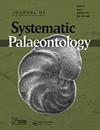A new tanystropheid (Diapsida: Archosauromorpha) from the Middle Triassic of SW China and the biogeographical origin of Tanystropheidae
IF 2.2
2区 地球科学
Q3 EVOLUTIONARY BIOLOGY
引用次数: 0
Abstract
AbstractTanystropheidae is a clade of early archosauromorphs with high morphological disparity and a wide geographical distribution. The origin and early radiation of Tanystropheidae are still incompletely understood. Here we report Luxisaurus terrestris gen. et sp. nov., a new archosauromorph collected from the marine Upper Member of Guanling Formation (Pelsonian substage, Anisian, Middle Triassic) in Luxi County, Yunnan Province, China, and phylogenetically recovered as a tanystropheid. The morphology of Luxisaurus is consistent with a terrestrial lifestyle. This is the first occurrence of a tanystropheid found from the Anisian Guanling Formation in SW China and also the earliest tanystropheid from the eastern Tethys. Phylogenetic analysis shows that Dinocephalosauridae forms the sister group of Tanystropheidae, Fuyuansaurus occupies the most basal position in Tanystropheidae, and Luxisaurus forms the sister group to a clade consisting of all other tanystropheids. Considering that Fuyuansaurus and Luxisaurus are found exclusively in South China, we hypothesize that Tanystropheidae originated in the Early Triassic of South China and then dispersed globally. The discovery of Early Triassic tanystropheids in South China is needed to further support this hypothesis. The discovery of Luxisaurus expands the stratigraphical and geographical distribution of Tanystropheidae, and provides new insights into the origin and early radiation of the clade.http://zoobank.org/urn:lsid:zoobank.org:pub:07DE12AC-8AE7-48F0-8BAD-0B73F04C0858Keywords: marine reptileDinocephalosauridaephylogenyGuanling Formation AcknowledgementsWe thank Y. W. Hu, Q. Li, A. S. Wolniewicz and J. He for the discussion of the specimen, other members of the Paleontological Lab of HFUT for their help in the field, T. Sato and L. Y. Li for preparation of the specimen, and S. N. F. Spiekman for help in the phylogenetic analysis. Constructive comments from S. N. F. Spiekman and N. C. Fraser helped improve the manuscript.Supplemental materialSupplemental material for this article can be accessed here: https://doi.org/10.1080/14772019.2023.2250778.Associate Editor: Richard ButlerAdditional informationFundingThis work was supported by the National Natural Science Foundation of China (42172026 and 41772003) and the Department of Natural Resources of Anhui Province (2021-g-2-16).中国西南中三叠世一新种田氏蛙(田氏纲:原蜥脚类)及田氏蛙科生物地理起源
摘要蝶科是一种形态差异大、地理分布广泛的早期始祖形动物分支。坦氏蝇科的起源和早期辐射仍不完全清楚。本文报道了在中国云南省鲁溪县中三叠世安尼期海相关岭组上段(Pelsonian亚阶段)中发现的一种新的原蜥脚类Luxisaurus terrestris gen. et sp. nov.。Luxisaurus的形态与陆地上的生活方式一致。这是在中国西南部安尼西亚关岭组首次发现的剑鞘类动物,也是在特提斯东部最早发现的剑鞘类动物。系统发育分析表明,龙头龙科是剑齿虎科的姊妹类群,福源龙在剑齿虎科中处于最基础的位置,Luxisaurus是剑齿虎科所有分支的姊妹类群。考虑到福源龙和Luxisaurus仅在华南地区发现,我们推测Tanystropheidae起源于华南早三叠世,然后在全球范围内扩散。华南地区早三叠世tanystropheids的发现需要进一步支持这一假设。Luxisaurus的发现扩大了Tanystropheidae的地层和地理分布,并为该分支的起源和早期辐射提供了新的见解。http://zoobank.org/urn:lsid:zoobank.org:pub:07DE12AC-8AE7-48F0-8BAD-0B73F04C0858Keywords:我们感谢Hu Y. W., Li . Q., A. S. Wolniewicz和J. He对标本的讨论,感谢HFUT古生物实验室其他成员在野外的帮助,感谢T. Sato和L. Y. Li对标本的准备,感谢S. N. F. Spiekman对系统发育分析的帮助。S. N. F. Spiekman和N. C. Fraser的建设性意见帮助改进了手稿。补充资料本文的补充资料可在这里访问:https://doi.org/10.1080/14772019.2023.2250778.Associate编辑:Richard butler补充资料资助:国家自然科学基金项目(42172026和41772003)和安徽省自然资源厅项目(2021-g-2-16)。
本文章由计算机程序翻译,如有差异,请以英文原文为准。
求助全文
约1分钟内获得全文
求助全文
来源期刊
CiteScore
5.30
自引率
7.70%
发文量
31
审稿时长
>12 weeks
期刊介绍:
The Journal of Systematic Palaeontology publishes papers that provide novel and impactful results in phylogenetics and systematics and that use these results in ways that significantly advance rigorous analyses of palaeogeography, palaeobiology, functional morphology, palaeoecology or biostratigraphy. Papers dealing with theoretical issues or molecular phylogenetics are also considered if they are of relevance to palaeo-systematists. Contributions that include substantial anatomical descriptions, descriptions of new taxa or taxonomic revisions are welcome, but must also include a substantial systematics component, such as a new phylogeny or a revised higher-level classification. Papers dealing primarily with alpha-taxonomic descriptions, the presentation of new faunal/floristic records or minor revisions to species- or genus-level classifications do not fall within the remit of the journal.

 求助内容:
求助内容: 应助结果提醒方式:
应助结果提醒方式:


